In common with other parts of the Armed Services, animals were used by Airborne Forces during the Second World War. These included 'Para Dogs' trained to parachute alongside the troops.
They were very important to the men after landing and were called upon to undertake guard, mine-detecting and patrol duties. Their acute senses provided an 'early-warning system` which was of great comfort and undoubedtly saved many lives.
The Scout Platoon of 13th (South Lancs) Parachute Battalion was the main unit which used Para Dogs. Their dogs included Bing, Brian, Flash, Monty, Ranee and Bob, a captured German dog. All were German Shepherds and male, except Ranee. The Platoon was initially commanded by Jack Sharples and later by Peter Downward. Its members were all dog lovers and included handlers Ken Bailey, Lloyd Neale, Bill Rutter and Wally Walton. Several of the dogs were dropped into Normandy in June 1944, and later over the Rhine in March 1945.
Brian (WDTS No. 2720/6871) was an Alsatian born in 1942 who was bought by his owner Betty Fetch for her eighteenth birthday. In 1943, Betty heard on the radio that the War Office required certain types of dogs for service. Lacking food to give him owing to the shortages and knowing she would get him back, she decided to offer Brian. He was two years old when he joined The Parachute Regiment in 1944, after basic training at the Army War Dog Training School. He was posted to the Recce Platoon, 13th Parachute Battalion to complete his parachute training, making the required number of jumps and earning his wings.
He parachuted into Normandy in June 1944 with his handler, before returning to Britain after passing through quarantine.
At the end of the war, Brian was demobbed from the army and returned to live with his owner, Betty Fetch. She insisted on his return despite a request from the War Office to purchase the dog and was apparently quite solicitous, asking after his health. In 1999, Betty gave her recollections to the researcher Laurie Goldstraw. She was waiting on the platform when Brian returned and noted he "looked a little unsure of himself". She said "hello you old Softie" and the Alsatian rolled over in recognition for a belly rub. On 26 April 1947, he received the PDSA Dickin Medal during a ceremony at the PDSA Headquarters. This was the animal equivalent to the Victoria Cross (VC), and it provided recognition of gallantry and devotion to duty.
His citation reads: “This patrol dog was attached to a Parachute Battalion of the 13th Batt. Airborne Division. He landed in Normandy with them and, having done the requisite number of jumps, became a fully-qualified Paratrooper.”
On 26 October 1955, Brian passed away, aged 13 years old, and was buried at the PDSA Animal Cemetery in Ilford, Essex.
Bing (WDTS No. 2738/6218) was also attached to the 13th Parachute Battalion. He was born in 1942 or 43. He had been loaned to the Battalion by Lieutenant Cyril William John Cory of the Royal Marine Engineers. Bing parachuted into Normandy on D Day in June 1944, landing in a tree where he stayed for two or three hours until he could be rescued the next morning by his handler Ken Bailey. He was apparently injured in the chest and eye after being hit by enemy mortars, but only superficially. He was back fighting in less than two days in the Bavent wood area.
Bing stood guard for his Battalion during heavy bombardment, despite having been wounded during the parachute drop. He was described by "Dixie" Dean as the "only one of them [who] could cope with the incessant mortaring and shelling to which we were subjected". He was known to spot "hidden enemies by freezing like a pointer" and, according to Dee Swann who was attached to the WDTS, "wore wings on his collar". He returned to Britain where he was quarantined, being released in time to travel to Germany to take part in the crossing of the Rhine. He and Bailey jumped together again as part of Op Varsity on March 25th, 1945.
Bing subsequently featured in Soldier magazine of March 1946, where he was described as a "three year-old Alsatian [...] because he is such an expert [he] has been bought from his owner by the Government and is now on the permanent staff of the War Dog School".
After the war he was bought by the War Department, and although recommended for the Dickin Medal, he was deemed not eligible as he was no longer privately owned. This was partly because he was still in service and therefore not able to attend the ceremony. However it has been alleged that the medal push was cancelled in general because some war dogs had been "humanely destroyed" - an unsavoury fact that was not to be made public. The RAVC was put in a difficult position on the one hand by owners who did not want their dogs back, and on the other by dogs who were now too vicious to adapt to civilian life. However, it is not known precisely what happened to Bing. Ken Bailey died in January 1999 and his ashes were scattered where he and Bing had landed in the early hours of D-Day.
At some point in time, probably in the 1990s, Para Dogs Bing and Brian were conflated and started to be referred to as the same dog - with Brian allegedly being his civilian name. The first instance of this mistake I can find is in a letter from Major General Peter Downward to Steve Blackbourn, curator of the Airborne Forces Museum at Aldershot, dated October 3, 1996. Downward states that Bing was the dog that earned the Dickin Medal. This mistake was later repeated by Blackbourn and many others who combined Bing and Brian. However, it is important to note that these were two separate Alsatians who were both attached to the 13th Parachute Battalion. This was probably an honest mistake which was not helped by the fact that the original handlers could apparently not remember if there was one dog or two.
Blackbourn was aware of the problem and later stated "generally speaking, the available information about paradogs is vague at best and many accounts frequently contradict each other [...] This subject is, I am afraid, a case of 'separating the wood from the trees"
Several other Para Dogs are known. 9th (Essex) Parachute Battalion had Bereda and Glen with handlers Jimmy Gardner and Emile Corteil, whilst 1st (Canadian) Parachute Battalion had Johnny with handler Peter Kowalski. These dogs were also Alsatians. Both Glen and Johnny are known to have dropped into Normandy, Glen with his handler Private Corteil on 6 June 1944.
The Paratroopers landed scattered over a large area, and a group of them formed up under Brigadier Hill to march to their rendezvous, several miles away. As they went, they came under attack from Allied aerial bombardment, during which both Pte Corteil and Glen were killed. They were buried together in Ranville War Cemetery, Normandy.
Sally was a brown and white terrier cross-breed adopted by the 10th Parachute Battalion while it was stationed at the METS in Kabrit (Egypt). She was one of many dogs who were adopted from nearby villages by the men. She was fitted with a tiny jump harness and parachute, but whether she received her Para wings is not known. When the Battalion moved to Ramat David (Palestine), the 10th's Adjutant ordered "all non-military dogs were NOT, repeat NOT, to accompany the Battalion on the move and were to remain in situ". However, such was the affection for Sally that the 10th Bn men approached the RAF Jump Instructors, who agreed to move Sally for them. Therefore, Sally the Para dog accompanied the Battalion to Palestine.
A Fox Terrier, Salvo trained with the US Airborne, and a Border Collie, Rob, jumped with SAS patrols in North Africa and Italy.
On 22 January 1945 Rob was awarded the PDSA Dickin Medal. His citation reads:
“Took part in landings during the North African Campaign with an Infantry unit and later served with a Special Air Unit in Italy as patrol and guard on small detachments lying-up in enemy territory. His presence with these parties saved many of them from discovery and subsequent capture or destruction. Rob made over 20 parachute descents.”
At the end of the war, Rob returned to Britain and was returned to his owner, Mrs Bayne, in 1945. His medals, which were stolen en route, were replaced by the War Office.
Rob was put down on 18 June 1956 aged 12.
Ranee was Ken Bailey's own dog. She was returned home to Liverpool after the completion of her training, not being used in operational parachute drops. According to Ken's brother Norman she was "a clever dog and easily taught 'party' tricks".
It is not known how much the dogs enjoyed the parachuting. It is thought that Bing sometimes had to be encouraged out of the aircraft with a helpful nudge to his rear!
For their advice, research and support, the Museum thanks John Pragnell and Irvins, the South Eastern Museums Service and Maj Gen Peter Downward CB DSO DFC.
Other 'Para Dogs'
Dogs have also been carried as 'mascots' (sometimes jumping precariously with one of the men!). Note the picture of 'Chalkey in Palestine, 1946'.
Today, the role is less common although some Parachuting nations retain the Para Dogs, including the Portuguese Para-Quedistas (see linked photos).
Source:
Compiled with information from:
Christy Campbell, The Brian Identity, Pets in Peril Blog
Airborne Assault Archive, box number 3F4 4.9.1
Arnhem: Eight Days to Oblivion: 10th Battalion, The Parachute Regiment 1942-44 (2024), Grahame Warner
Article written and edited by Tom Lusby, Jon Baker, Sam Stead and Alex Walker
Read More
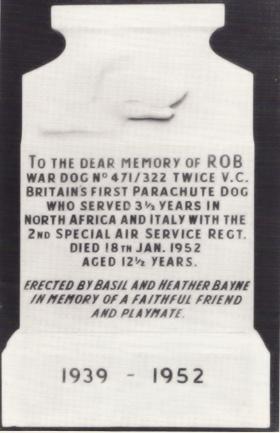
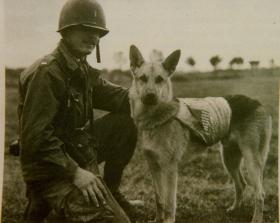
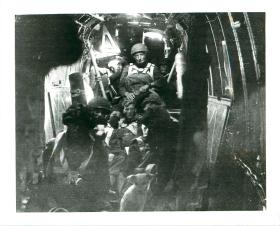
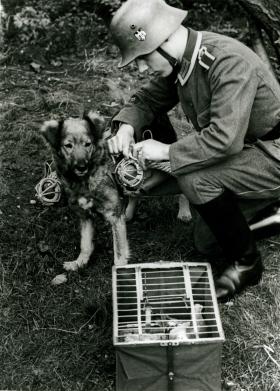
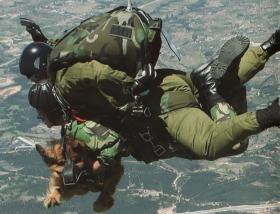
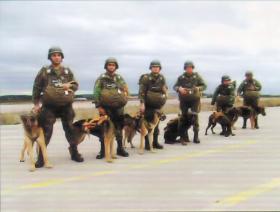
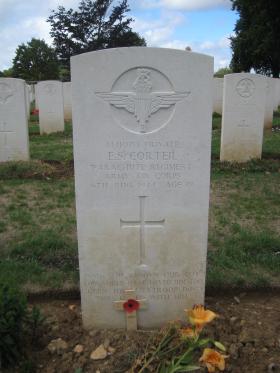
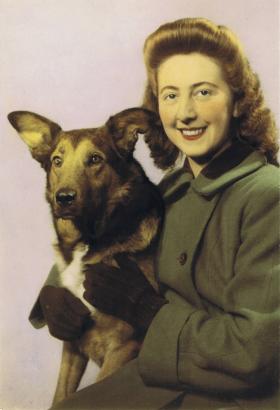
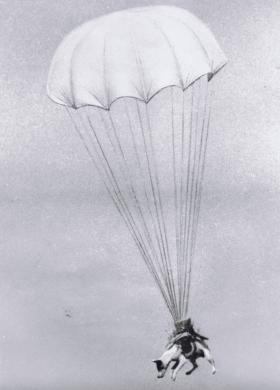
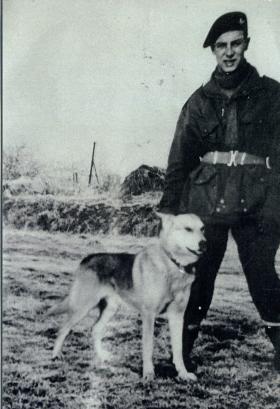
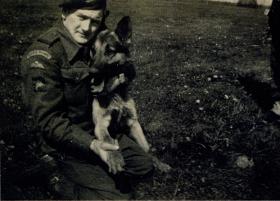
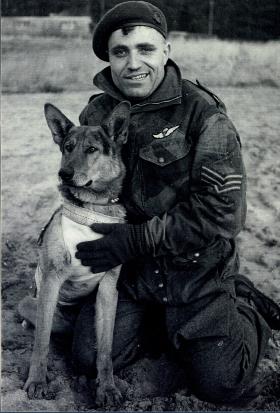
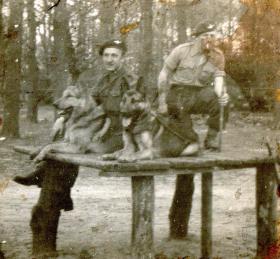

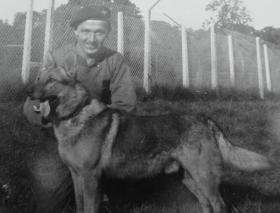
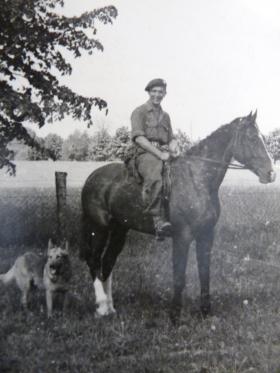
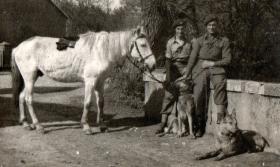
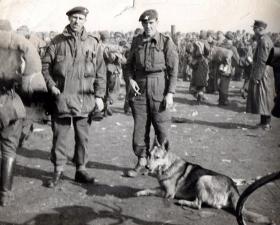
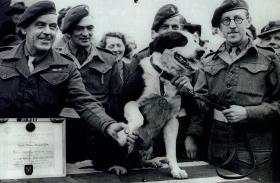
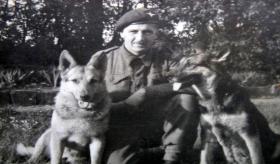
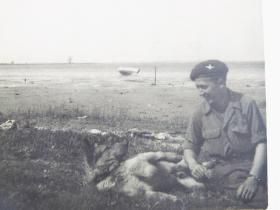
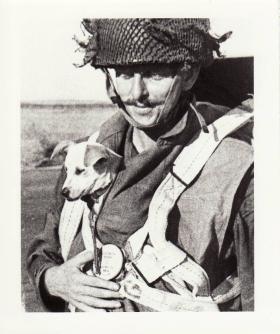
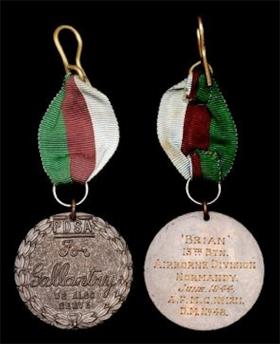
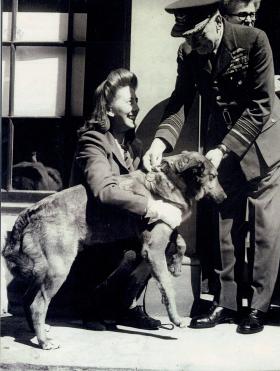
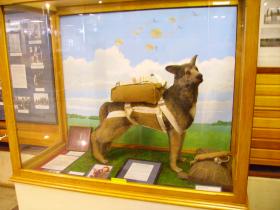
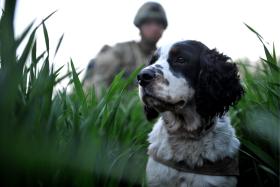
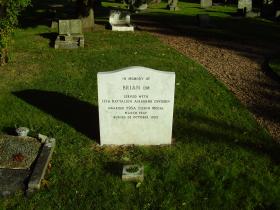
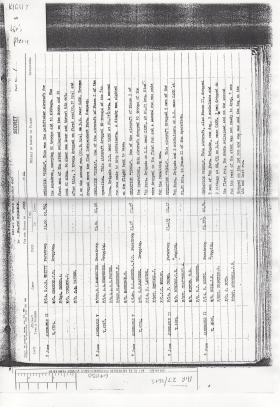
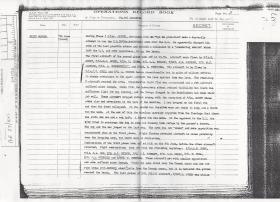
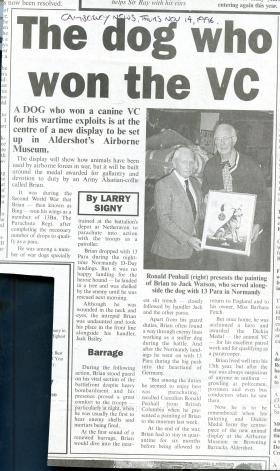
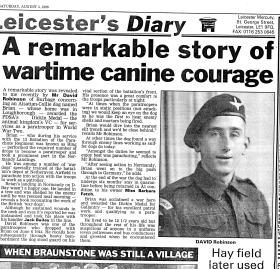
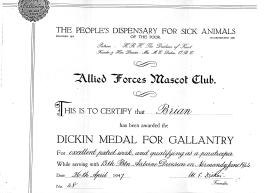
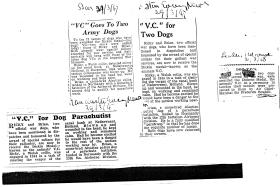
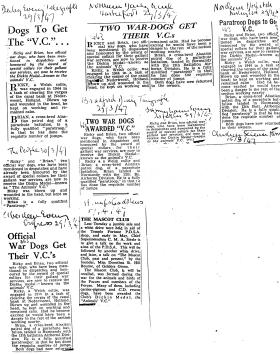
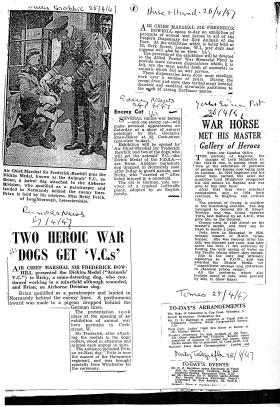
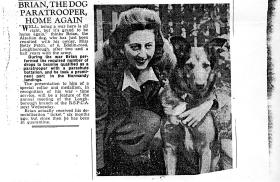
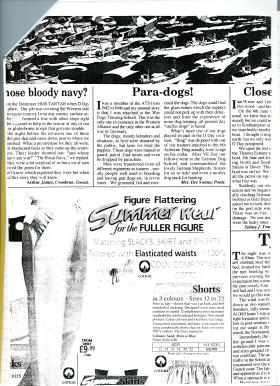
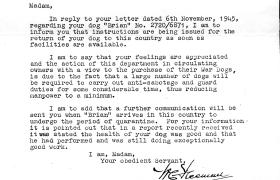
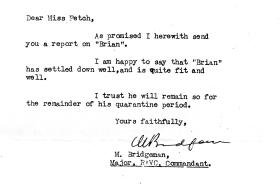
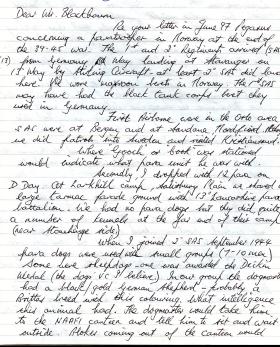
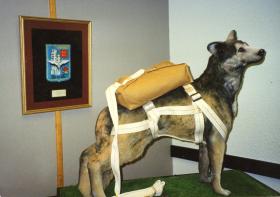
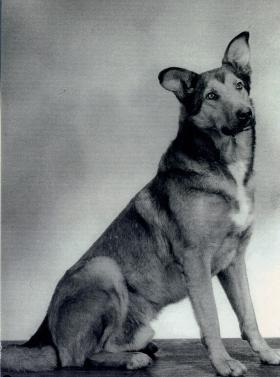
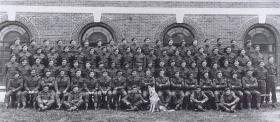
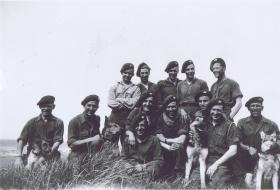
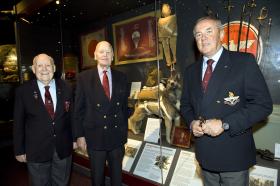
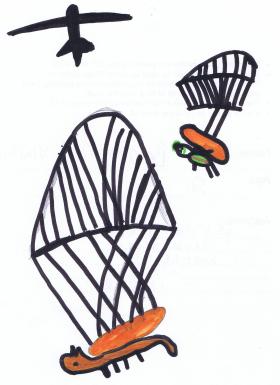



Latest Comments
Family story is that Dai dropped with the 6th but I have never been able to find any details from family or elsewhere.
Whether Dai came back from Europe or from Palestine is also unclear.
It would be good to add to the above stories with any details that anyone could share.
Add Comment
In order to add comments you must be registered with ParaData.
If you are currently a ParaData member please login.
If you are not currently a ParaData member but wish to get involved please register.